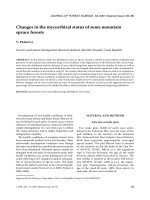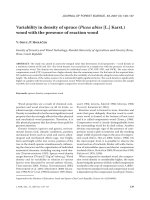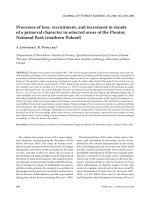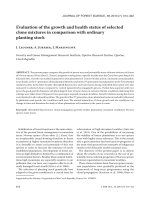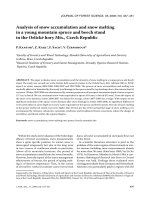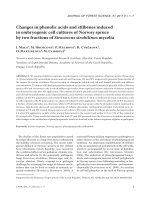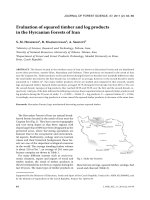Báo cáo lâm nghiệp: "Changes in carbon uptake and allocation patterns in Quercus robur seedlings in response to elevated an 2 CO and water stress: C 13 labelling" pps
Bạn đang xem bản rút gọn của tài liệu. Xem và tải ngay bản đầy đủ của tài liệu tại đây (965.55 KB, 13 trang )
Original
article
Changes
in
carbon
uptake
and
allocation
patterns
in
Quercus
robur
seedlings
in
response
to
elevated
CO
2
and
water
stress:
an
evaluation
with
13
C
labelling
P
Vivin.
JM
Guehl*
Équipe
bioclimatologie
et
écophysiologie forestières,
Inra
Nancy,
54280
Champeoux,
France
(Received
11
April
1997;
accepted
2 July
1997)
Summary - A
semi-closed
13CO
2
labelling
system
(1.5%
13C)
was
used
to
assess
both
carbon
uptake
and
allocation
within
pedunculate
oak
seedlings
(Quercus
robur
L)
grown
under
ambient
(350
vpm)
and
elevated
(700
vpm)
atmospheric
CO
2
concentration
([CO
2
])
and
in
either
well-watered
or
droughted
conditions.
Pulse-chase
13
C
labelling
data
highlighted
the
direct
positive
effect
of ele-
vated
CO
2
on
photosynthetic
carbon
acquisition.
Consequently,
in
well-watered
conditions,
CO
2-
enriched
plants
produced
1.52
times
more
biomass
(dry
mass
at
harvest)
and
1.33
times
more
dry
root
matter
(coarse
plus
fine
roots)
over
the
22-week
growing
period
than
plants
grown
under
ambient
[CO
2
].
The
root/shoot
biomass
ratio
was
decreased
both
by
drought
and
[CO
2
],
despite
lower
N
concentrations
in
CO
2
-enriched
plants.
However,
both
long-term
and
short-term
C
allocation
to
fine
roots
were
not
altered
by
CO
2.
and
relative
specific
allocation
(RSA),
a
parameter
expressing
sink
strength,
was
higher
in
all
plant
organs
under
700
vpm
compared
to
350
vpm.
Results
showed
that
C
availability
for
growth
and
metabolic
processes
was
greater
in
fine
roots
of
oaks
grown
under
an
elevated
CO
2
atmosphere
irrespective
of soil
water
availability.
elevated
CO
2
/ drought
/
growth
/
13
C
labelling
/
carbon
assimilation
/
carbon
allocation
Résumé -
Effets
de
l’augmentation
de
la
concentration
atmosphérique
en
CO
2
et
de
la
séche-
resse
sur
l’assimilation
et
la
redistribution
du
carbone
de
plants
de
Quercus
robur :
une
approche
par
marquage
13C.
Un
système
semi-fermé
de
marquage
isotopique
par
13CO
2
(1,5
%
13C)
a
été
uti-
lisé
pour
évaluer
l’assimilation
et
la
répartition
du
carbone
pour
des
plants
de
chêne
(Quercus
robur
L)
élevés
sous
une
concentration
atmosphérique
en
CO
2
([CO
2
])
ambiante
(350
vpm)
ou
élé-
vée
(700
vpm)
et
en
conditions
d’alimentation
hydrique optimale
ou
limitante.
Les
résultats
obtenus
à
partir
de
cinétiques
de
charge-redistribution
de
13
C
montrent
un
effet
direct
de
l’augmentation
de
[CO
2]
sur
l’acquisition
photosynthétique
de
carbone.
En
conditions
d’alimentation
hydrique
optimale,
*
Correspondence
and
reprints
Tel:
(33)
383
39 40 36;
fax:
(33)
383
39 40 69;
e-mail:
la
biomasse
totale
des
plants
croissant
sous
[CO
2]
élevée
a
été
multipliée
par
1,52
(matière
sèche
à
la
fin
de
la
période
de
croissance
de
22
semaines)
comparativement
au
plants
croissant
sous
[CO
2]
ambiante,
cependant
que
la
matière
sèche
des
racines
(racines
fines
et
grosses)
était
multipliée
par
1,33.
Le
rapport
biomasse
racinaire/biomasse
aérienne
des
plants
était
diminué
à
la
fois
par
la
sécheresse
et
par
l’augmentation
de
[CO
2
],
en
dépit
de
concentrations
tissulaires
en
N
plus
faibles
dans
les
plants
croissant
en
conditions
de
[CO
2]
élevée.
Toutefois,
l’allocation
de
carbone
aux
fines
racines
(diamètre
<
2
mm),
considérée
soit
de
façon
intégrée
dans
le
temps
(accumulation
de
biomasse),
soit
à
court
terme
(données
issues
des
marquages
isotopiques),
n’était
pas
affectée
par
la
[CO
2
].
Le
taux
d’allocation
spécifique
de
carbone
(RSA),
un
paramètre
exprimant
la
force
des
puits
de
carbone,
était
plus
élevé
à
700
vpm
qu’à
350
vpm
pour
l’ensemble
des
compartiments
des
plants.
Les
résul-
tats
font
ressortir
une
augmentation
de
la
disponibilité
en
C
pour
la
croissance
et
le
métabolisme
dans
les
fines
racines
en
relation
avec
l’augmentation
de
[CO
2]
et
indépendamment
des
disponibili-
tés
hydriques
dans
le
sol.
CO
2
élevé
/
sécheresse
/
croissance
/
marquages
13
C
/
assimilation
du
carbone
/
redistribution
du
carbone
INTRODUCTION
There
is
now
good
agreement
among
dif-
ferent
climate
models
that
accumulation
of
carbon
dioxide
and
other
greenhouse
gases
in
the
atmosphere
linked
to
human
activi-
ties
could
cause
an
increase
in
mean
global
temperature
at
the
surface
of
the
earth
of
at
least
1 °C
over
the
next
50
years
and
of
about
2-4
°C
before
the
end
of
the
next
century.
Owing
to
both
the
increase
in
potential
evap-
otranspiration
linked
to
these
changes
and
to
concurrent
changes
in
the
precipitation
regime
at
the
European
temperate,
and
namely
Mediterranean,
latitudes
forecasted
by
General
Circulation
Models,
plant
com-
munities
will,
in
addition
to
enhanced
tem-
perature,
have
to
face
more
severe
drought
conditions
in
the
future,
and
will
therefore
be
subjected,
particularly
in
the
case
of long-
living
woody
communities,
to
increasing
risks
of
environmental
inadaptation
and
dye-
back
(Beerling et
al,
1996).
Atmospheric
CO
2
concentration
([CO
2
])
is
presently
360
vpm,
and
could
reach
530
vpm,
ie,
about
twice
the
preindustrial
level
of
last
century,
by
the
year
2050,
and
700
vpm
in
2100
(Post
et
al,
1990). In
their
recent
evolutionary
history,
plants
have
never
experienced
such
elevated
CO
2
together
with
drought.
There
are
several
mechanisms
by
which
atmospheric
CO
2
may
interfere
with
drought
adaptation
fea-
tures
of plants.
Elevated
atmospheric
CO
2
is
known
to
generally
stimulate
water-use
effi-
ciency
in
trees
primarily
as a
result
of
low-
ered
leaf
stomatal
conductance,
enhanced
photosynthesis
or
both
factors
in
combina-
tion
(Eamus,
1991;
Guehl
et
al,
1994),
allowing
the
maintenance
of
higher
leaf
water
potentials
at
a
given
soil
water
content
(Masle,
1992; Tyree
and
Alexander,
1993).
However,
drought
resistance
mechanisms
could
also
be
largely
determined
by
pro-
cesses
occurring
after
carbon
assimilation,
ie,
by
the
efficiency
of
C
transfer
to,
and
utilization
by,
the
sink
organs.
Much
fewer
studies
have
focused
on
this
latter
aspect.
An
increased
C-sink
activity
of
the
root
sys-
tem,
promoted
by
the
allocation
of recently-
fixed
carbon,
is
often
reported
in
CO
2-
enriched
trees
(Stulen
and
Den
Hertog,
1993;
Norby,
1994;
Rogers
et
al,
1994;
Vivin
et
al,
1995),
and
may
enhance
the
potential
for
water
and
nutrient
acquisition
through
a
greater
absorptive
root
area
and
a
higher
specific
root
activity
(Rogers
et
al,
1994;
Morgan
et
al,
1994).
Increased
C
availability
in
the
different
plant
tissues
is
also
likely
to
promote
osmotic
adjustment,
which
leads
to
the
maintenance
of
turgor
potential
and
plant
growth
under
drought
(Morse
et
al,
1993;
Tschaplinski
et
al,
1995b;
Vivin
et
al,
1996;
Picon
et
al,
1997).
The
use
of
stable
13
C
isotope
as
a
tracer
is
a
powerful
approach
to
assess
whole-tree
C
allocation
(Deléens
et
al,
1995;
Vivin
et
al,
1995).
In
the
present
study,
we
examined
to
what
extent
growth,
carbon
uptake
and
allocation
to
fine
roots,
coarse
roots,
stem
and
leaves
of
pedunculate
oak
(Quercus
robur
L)
seedlings
are
changed
by
the
inter-
active
effects
of
atmospheric
[CO
2]
and
soil
water
availability.
Q
robur
is
a
deciduous
drought-tolerant
species
with
a
deep
root-
ing
pattern,
allowing
efficient
soil
water
extraction,
and
is
of
major
area
representa-
tivity
in
France
(Vivin
et
al,
1993).
We
hypothesized
that
elevated
CO
2
would
stim-
ulate
plant
growth
and
carbon
uptake,
even
if
soil
water
availability
is
limiting,
and
would
increase
both
carbon
allocation
and
C
availability
to
the
below-ground
system.
Such
patterns
may
be
a
key
in
the
extent
to
which
elevated
CO
2
may
alleviate
the
effects
of
water
stress
in
plants
(Bazzaz,
1990;
Morison,
1993).
MATERIALS
AND
METHODS
Plant
material
and
experimental
setup
Pedunculate
oak
acorns
(Q
robur
L,
provenance
Manoncourt)
were
collected
in
Autumn
1993
in
a
parent
stand
close
to
Nancy
(Lorraine,
France),
soaked
in
fungicide
(Rhodiasan,
Rhône
Poulenc
Paris,
France)
and
stored
at-1 °C
in
plastic
bags
over-winter.
In
March
1994,
the
acorns
were
peeled,
soaked
in
water
and
sown
in
5-L
cylin-
drical
plastic
containers
filled
with
a
shagnum-
peat
and
sand
mixture
(1/1,
v/v).
The
substrate
was
fertilized
with
delayed
Nutricote
100
(N,
P,
K
13-13-13
+ trace
elements)
at
the
time
of
sow-
ing,
and
the
level
of
fertilizer
supply
(5
kg
m
-3
)
was
chosen
to
provide
optimal
plant
nutrition
conditions
throughout
the
experimental
period.
Sixty
pots
were
randomly
assigned
to
two
groups
of
30
replicates,
and
placed
inside
two
50-μm -
thick
transparent
polypropylene
tunnels
(5 x
3
x
2.3
m)
located
at
Inra -
Nancy.
Seedlings
were
continuously
exposed
to
either
ambient
(350
±
30
vpm)
or
high
(700
±
50
vpm)
atmospheric
[CO
2
]s,
which
were
measured
by
means
of
two
infrared
gas
analyzers
(ADC
225
MK3,
UK)
and
controlled
by
an
automated
regulation
system
(Guehl
et
al,
1994;
Vivin
et
al,
1995).
Air
tem-
perature
inside
the
tunnels
ranged
from
11 °C
(minimum
night
temperature)
to
30
°C
(maxi-
mum
diurnal
temperature)
during
the
experi-
mental
period;
maximum
daily
values
of
VPD
ranged
from
10.1
to
20.2
hPa.
Plants
were
grown
under
natural
photoperiod.
Photosynthetic
pho-
ton
flux
density
(PPFD)
was
about
60%
of
the
outside
conditions
and
did
not
exceed
1 200
μmol
m
-2
s
-1
at
plant
level,
even
in
sunny
conditions.
All
plants
were
watered
with
deionized
water
twice
a
week
to
maintain
soil
water
content
to
field
capacity.
Eighteen
weeks
after
germina-
tion,
15
seedlings
were
randomly
assigned
in
each
tunnel,
to
well-watered
or
water-stressed
treatments,
and
water
supply
was
withheld
in
the
latter
treatment.
Plant
transpiration
was
assessed
gravimetrically
and
direct
evaporation
from
the
containers
was
prevented
by
covering
the
sub-
strate
with
white
waxed
cardboard
disks.
Leaf
predawn
water
potential
(Ψ
w)
of
mature
leaves
was
measured
with
a
Scholander
pressure
cham-
ber
simultaneously
to
plant
sampling.
13
C
labelling
experiment
At
the
end
of
August
(week
22
after
sowing),
eight
plants
from
each
CO
2
treatment
were
ran-
domly
selected
from
the
set
of
15
and
placed
in
a
controlled
environment
chamber
for
a
short-
term
13
C
labelling
experiment.
The
labelling
sys-
tem
described
in
detail
elsewhere
(Vivin
et
al,
1995)
was
designed
(i)
to
supply
a
constant
13C-
enriched
CO,
atmosphere
to
the
shoots
(1.5
atom%,
or ca
0.4%
over
the
ambient
atmo-
spheric
level)
and
(ii)
to
monitor
[CO
2]
in
both
above-
and
below-ground
compartments
of
the
plant-soil
system
in
accordance
with
plant
grow-
ing
[CO
2
].
Air
temperature
within
the
above-
ground
compartment
was
23 °C,
relative
humidity
was
up
to
70%
and
PPFD
was
350
μmol
m
-2
s
-1
at
leaf
level,
which
was
close
to
the
mean
photosynthetic
photon
flux
density
(PPFD)
level
received
by
the
plants
in
the
tunnels.
Three
plants
were
harvested
after
the
12-h
loading
period;
the
five
remaining
plants
were
harvested
after
a
60-h
chase
period
(three
nights
and
two
days),
simultaneously
to
five
unlabelled
plants
(to
measure
baseline
plant
13
C
abundance).
Plants
were
separated
into
leaves,
stems,
coarse
roots
(comprising
mainly
the
tap
root)
and
fine
roots
(<
2
mm
diameter).
The
leaf
area
from
the
three
aerial
growth
flushes
produced
(flush
1
denotes
the
oldest
one)
was
measured
using
a
planimeter
(DeltaT
Devices,
UK).
Roots
were
separated
from
soil
by
gently
shaking
and
washed
with
deionized
water.
Plant
components
were
dried
at
65 °C
for
48
h
and
finely
ground
to
pass
a
40-mesh
screen.
Powdered
plant
tissues
were
combusted
at
1050
°C,
and
their
C
and
N
con-
centrations
and
the
molar
13C/12
C
ratio
were
measured
using
an
element
analyser
coupled
with
an
isotope
ratio
mass
spectrometer
(Delta
S,
Finnigan-Mat,
Bremen,
Germany).
Isotopic
results
were
expressed
in
terms
of
the
conven-
tional
δ
13
C
PDB
notation
(Boutton,
1991).
Distri-
bution
of newly
incorporated
13
C
atoms
within
a
plant
was
expressed
in
two
complementary
ways
as
relative
specific
allocation
(RSA)
and
parti-
tioning
(%P,
see
Appendir
1
for
expressions).
RSA
describes
the
proportion
of
newly
incorpo-
rated
atoms
relative
to
total
atoms
in
a
given
sample,
and
is
also
interpreted
as
an
index
of
C
turnover
whereas
%P
describes
the
proportion
of
the
labelled
element
in
a
given
sample
rela-
tive
to
the
total
labelled
element
in
that
plant
(Deléens
et
al,
1995).
Simultaneously
to
the
13
C
labelling
experi-
ment,
biomass
and
allometric
parameters
were
assessed
by
measuring
plant
leaf
area,
root/shoot
(R/S,
g
g
-1
)
mass
ratio,
fine
root
mass
ratio
(fine
root
mass/plant
mass,
g
g
-1),
fine
root
density
(fine
root
mass/plant
leaf
area,
g
dm-2
)
and
growth
efficiency
(annual
stem
mass
per
plant
leaf
area,
g
dm-2).
Biomass
partitioning
among
the
plant
components
was
assessed
by
deter-
mining
(1)
the
leaf
mass
ratio
(LMR,
leaf
dry
mass/whole
plant
dry
mass,
g
g
-1),
(2)
the
stem
mass
ratio
(SMR,
stem
dry
mass/whole
plant
dry
mass,
g
g
-1),
(3)
the
root
mass
ratio
(RMR,
root
mass/whole
plant
mass,
g
g
-1).
Data
analysis
Daily
monitoring
indicated
that,
with
the
excep-
tion
of atmopheric
[CO
2
],
environmental
condi-
tions
were
similar
between
the
two
tunnels.
In
order
to
minimize
possible
tunnel
effects,
plants
were
rotated
monthly
between
tunnels.
The
experiment
was
a
two
by
two
factorial
to
deter-
mine
the
effects
of
CO
2
and
water
on
plant
vari-
ables.
The
individual
container
was
considered
as
the
experimental
unit.
Data
were
analysed
using
a
two-way
ANOVA
to
test
for
significant
(P
<
0.05)
treatment
differences
in
plant
vari-
ables.
RESULTS
Water
relations
After
the
22-week
experimental
period,
well-watered
plants
had
similar
leaf
predawn
water
potential
values
(Ψ
w
= -0.44
MPa)
in
both
[CO
2
]s
(table
I).
The
drought
treat-
ment,
which
was
started
on
week
18,
sig-
nificantly
decreased
Ψ
w
in
both
CO
2
treat-
ments,
but
this
effect
was
slightly
more
pronounced
under
elevated
[CO
2]
(-2.6
MPa)
than
under ambient
[CO
2]
(-1.9
MPa).
Plant
transpiration
measured
from
week
18
to
the
end
of
the
experiment
was
unaffected
by
CO
2,
but
was
decreased
by
drought
(-29
and -18%
under
ambient
and
elevated
[CO
2
],
respectively;
table
I).
Plant
growth
and
biomass
Q
robur
plants
generally
produced
three
aerial
growth
flushes
during
the
experi-
mental
period
(table
II).
No
significant
CO
2
effect
on
stem
length
was
observed
for
the
first
flush,
which
probably
reflects
the
pre-
dominant
contribution
of
acorn
reserve
mobilization.
For
the
second and
third
growth
flush,
a
significant
stimulation
of
stem
length
by
elevated
[CO
2]
was
observed
in
both
well-watered
and
droughted
plants
(table
II).
At
the
end
of
the
experiment
in
the
well-watered
plants,
elevated
[CO
2]
sig-
nificantly
enhanced
root
collar
diameter
(+14%),
total
stem
length
(+25%),
number
of leaves
per
plant
(+32%)
as
well
as
plant
leaf
area
(+39%)
(table
II),
but
not
single
leaf
area.
Drought
significantly
decreased
all
growth
variables
in
both
CO
2
conditions,
no
CO
2
x
water
interactive
effects
were
observed
(table
II).
Well-watered
plants
grown
under
ele-
vated
[CO
2]
produced
1.52
times
more
total
biomass
and
1.33
times
more
dry
root
mat-
ter
(coarse
plus
fine
roots)
over
the
22-week
growing
period
than
plants
grown
under
ambient
[CO
2]
(table
II).
The
root
systems
of
plants
from
both
CO
2
treatments
extended
to
the
bottoms
of
the
pots.
Elevated
[CO
2]
had
no
effect
on
LMR,
but
significantly
increased
SMR
and
decreased
RMR
in
both
watering
conditions
(table
II).
Consequently,
root/shoot
ratio
was
23%
lower
in
well-
watered
plants
grown
under
high
[CO
2]
than
in
ambient
CO
2
-treatment
plants
(table
II).
Average
plant
specific
leaf
area
(SLA)
was
significanly
decreased
by
[CO
2
],
but
was
unaffected
by
drought
(table
II).
In
addi-
tion,
elevated
CO
2
promoted
a
significantly
higher
growth
efficiency
(+31%
in
well-
watered
conditions
and
+47%
in
droughted
conditions),
but
slightly
increased
fine
root
density
and
the
fine
root/coarse
root
ratio
(table
II).
C-N
concentrations
and
natural
13
C
isotope
composition
Elevated
CO
2
slightly
but
significantly
increased
whole-plant,
stem,
root,
but
not
leaf,
C
concentrations
in
both
watering
con-
ditions
(table
III).
Indeed
plant
N
uptake
was
significantly
increased
in
CO
2
-enriched
plants
(+35%,
in
well-watered
treatment)
but
not
enough
to
compensate
for
plant
C
uptake
(+52%).
Plant
N
concentration
and
C/N
ratio
over
the
22-week
growing
period
were
affected
by
the
elevated
[CO
2
],
by
-11
and
+13%,
respectively
(table
III).
Drought increased
plant
C
and
N
concen-
trations
in
both
CO
2
treatments.
Carbon
isotope
composition
of
all
plant
components
was
on
average
12‰
more
neg-
ative
in
unlabelled
plants
in
elevated
CO
2
than
in
ambient
CO
2
(fig
1).
Such
a
large
difference
can
only
be
accounted
for
by
dif-
ferences
in
source
air
isotopic
composition
(δ
a)
between
the
two
tunnels
and
not
by
dif-
ferences
in
isotopic
discrimination
by
the
plants.
The
plants
in
ambient
CO
2
exhib-
ited
δ
values
ranging
between
-27.7
and
-30.3‰,
which
are
consistent
with
a
δ
a
value
equal
to
that
of
the
outside
atmosphere
(ie,
-8‰).
The
mean
δ
a
value
in
the
ele-
vated
CO
2
tunnel
was
unknown
but
was
obviously
much
less
negative
than
-8‰,
reflecting
the
combined
influence
of
the
CO
2
from
the
cylinder
(typical
values
of
about
-35‰;
Ehleringer,
1991 )
and
from
the
greenhouse
(about
-8‰)
with
an
addi-
tional
(but
probably
small
because
of
the
continuous
air
extraction
from
the
tunnel)
effect
due
to
carbon
isotope
discrimination
by
the
plants
within
the
tunnel.
There
was
a
close
correlation
between
the
δ
values
of
the
different
plant
compo-
nents
at
the
individual
plant
level
(data
not
shown).
Roots
exhibited
δ
values
about
1.5‰
less
negative
(less
discrimination)
than
stems
and
leaves.
Similar
results
have
been
observed
in
other
studies
(Gebauer
and
Schulze,
1991;
Guehl
et
al,
1994),
but
their
interpretation
remains
unclear.
For
both
[CO
2
],
δ
13
C
increased
with
drought
(fig
1),
reflecting
stomatal
closure
and
decreased
leaf
intercellular
[CO
2]
in
the
droughted
conditions
(Farquhar
et
al,
1989;
Picon
et
al,
1997).
It
is
noteworthy
that
this
effect
of
drought
was
most
pronounced
in
the
most
recently
formed
plant
components,
ie,
in
leaves
of
the
third
flush
and
in
fine
roots
(elevated
[CO
2]
only).
This
probably
reflects
the
fact
that
these
components
were
formed
after
the
onset
of
drought,
thus
the
isotopic
signature
of
structural
C
was
affected
by
drought.
13
C
relative
specific
allocation
and
partitioning
Daily
plant
carbon
assimilation
rates,
cal-
culated
from
δ
values
of
the
labelled
plants
and
expressed either
on
a
plant
basis
(table
IV)
or
on
a
plant leaf
area
basis
(fig
2),
were
significantly
higher
in
the
elevated
CO
2
treatment
whatever
the
plant
water
status.
Drought
reduced
daily
plant
carbon
uptake
per
unit leaf
area,
but
values
remained
higher
under
elevated
[CO
2]
than
ambient
[CO
2]
despite
lower
leaf
predawn
water
potential
in
CO
2
-enriched
plants
(fig
2,
table
I).
In
the
well-watered
treatments,
relative
specific
allocation
values
(RSA),
consid-
ered
either
immediately
after
the
labelling,
or
after
the
60-h
chase
phase,
were
signifi-
higher
under
700
vpm
than
under
350
vpm
[CO
2]
at
the
whole-plant
level
and
in
all
plant
parts
(fig
3).
During
the
chase
phase,
the
recently
photoassimilated
13
C
was
translocated
from
the
mature
leaves,
in
which
the
proportion
of
new
carbon
decreased,
to
the
expanding
leaves
(3rd
flush),
stem
and
total
roots,
in
which
this
proportion
increased
(fig
3).
However,
sim-
ilarly
to
long-term
biomass
C
allocation,
short-term
13
C
partitioning
to
the
below-
ground
parts
was
less
pronounced
under
700
vpm
than
under
350
vpm
[CO
2]
(fig
4).
Elevated
CO
2
did
not
affect
C
allocation
to
fine
roots
(fig
4),
but
RSA
values
were
markedly
higher
in
the
fine
roots
under
ele-
vated
CO
2
(2.2%)
than
under
ambient
CO
2
(0.8%)
after
the
60-h
chase
period
(fig
3).
In
addition,
under
ambient
[CO
2
],
the
propor-
tion
of
new
13
C
was
practically
nil
after
the
60-h
chase
phase
in
the
leaves
of
the
first
and
second
flushes,
whereas
the
amount
of
new
13
C
remained
higher
under
elevated
[CO
2]
(fig
3).
Under
both
ambient
and
ele-
vated
[CO
2
],
drought
reduced
both
plant
RSA
(fig
3)
and
the
relative
proportion
of C
translocated
to
below-ground
parts
of
the
plants
(fig
4).
In
contrast
with
the
stimulation
of
C
acquisition
per
unit
leaf
area
(fig
2),
elevated
[CO
2]
did
not
increase
the
plant
RSA
value
(fig
3)
under
droughted
condi-
tions.
This
is
to
be
related
to
the
lower
leaf
area
ratio
values
observed
under
elevated
[CO
2
].
DISCUSSION
Carbon
uptake
rates
issued
from
the
13
C
labelling
data
highlighted
the
direct
posi-
tive
effect
of elevated
CO
2
on
C
acquisition
(fig
2,
table
IV),
and
are
consistent
with
pre-
vious
studies
that
have
indicated
a
pro-
nounced
photosynthetic
stimulation
in
Q
robur
in
response
to
CO
2
enrichment
(Vivin
et
al,
1995;
Picon
et
al,
1996a,
b).
Conse-
quently
well-watered
plants
grown
under
elevated
CO
2
produced
1.52
times
more
total
biomass
(dry
mass
at
harvest)
over
the
22-weeks
period
than
plants
grown
under
ambient
CO,
(table
II),
as
commonly
reviewed
in
woody
plants
(Poorter,
1993;
Ceulemans
and
Mousseau,
1994;
Wullschleger et
al,
1995)
and
namely
in
The
Quercus
genus
(Norby,
1996).
The
relative
magnitude
of
this
response
has
often
been
positively
related
to
water
and/or
nutrient
availability
in
the
growth
medium
(Conroy
et al,
1988; Johnsen,
1993;
Samuelson
and
Seiler,
1994;
Dixon
et
al,
1995,
Hibbs
et
al,
1995;
Picon
et
al,
1996a;
Townend,
1995)
and
to
the
genetic
capacity
of
plants
to
increase
the
size
or
the
number
of
their
C
sink
organs
(Kaushal
et
al,
1989;
Vivin
et
al,
1995).
It
is
also
noteworthy
that
our
1.32-
fold increase
in
annual
growth
efficiency
(table
II)
closely
corresponds
to
the
aver-
age
response
in
many
CO
2
-enrichment
experiments
with
woody
plants
(Wullschleger
et
al,
1994;
Norby,
1996).
In
the
present
study,
the
growth
and
biomass
of
stem,
which
represents
a
major
C
sink
spe-
cific
to
woody
plants
leading
to
the
consti-
tution
of
metabolically
inactive
C
pools
(namely
lignin
and
cellulose),
were
partic-
ularly
increased
in
response
to
elevated
CO
2
(table
II,
fig
3).
It
has
already
been
observed
that
elevated
CO
2
leads
to
increased
wood
density
and
increased
the
thickness
of
the
cell
walls
in
coniferous
species
(Conroy
et
al,
1990);
but
there
is
no
straightforward
conclusion
on
how
the
fractions
of
lignin
and
cellulose
are
affected
by
rising
atmo-
spheric
CO
2
in
trees.
Thus,
whether
the
amounts
of
carbon
fixed
in
such
metabol-
lically
inert
pools
differ
with
the
availability
of
carbohydrates
and
water
remains
an
open
question.
According
to
the
theory
of
the
balanced
shoot
and
root
activity
in
response
to
various
resources
(as
atmospheric
CO
2
concentra-
tion,
nutrients,
soil
water)
(Chapin,
1980),
a
stimulation
of
the
specific
activity
of
the
shoot
is
expected
to
increase
either
the
struc-
ture
or
the
function
of
the
root
system
in
order
to
balance
the
internal
resource
demand.
However,
although
plant
N
con-
centration
was
lower
in
CO
2
-enriched
well-
watered
plants
(table
III),
the
R/S
ratio
was
slightly
decreased
by
elevated
CO
2
in
this
experiment.
Such
an
observation
has
also
been
reported
in
a
few
other
studies
on
woody
species
(Norby
and
O’Neill,
1989;
Guehl
et al,
1994;
Tschaplinksi
et
al,
1995a;
Vivin
et
al,
1995;
Picon
et
al,
1996a)
and
is
not
consistent
with
the
basic
asumption
that
a
larger
proportion
of
the
recently
photoas-
similated
C
is
allocated
to
the
below-ground
structures
when
internal
resources
become
limiting
(Larigauderie et
al,
1988,
1994;
Sinclair,
1992;
El
Kohen
et al,
1992).
Fur-
thermore,
plants
grown
under
limiting
water
supply
generally
allocate
relatively
more
recently
fixed
C
to
the
below-ground
com-
partment
(Wilson
1988,
Geiger
and
Ser-
vaites,
1991);
this
effect
would
be
advan-
tageous
for
the
acquisition
of
water
under
field
conditions
(Tyree
and
Alexander,
1993;
Morison,
1993).
But
surprisingly
in
this
experiment,
not
only
the
R/S
ratio
but
also
short-term
(fig
4)
or
time-integrated
(table
II,
fig
4)
below-ground
C
allocation
were
reduced
by
drought
in
both
CO,
treatments.
Similar
obervations
were
made
in
Alnus
rubra
by
Arnone
and
Gordon
(1990)
and
by
Hibbs
et
al
( 1995).
In
fact
surveying
the
available
data
on
the
influence
of
elevated
CO
2
on
the
distribution
of
dry
matter
between
different
plant
organs
measured
as
the
R/S
ratio,
no
general
pattern
emerges
(Stulen
and
Den
Hertog,
1993;
Rogers
et
al,
1994;
Norby,
1994).
The
average
R/S
ratio
values
compiled
from
398
observa-
tions
on
73
tree
species
grown
in
elevated
CO
2
have
been
shown
to
remain
constant
over
a
broad
spectrum
of
soil
water
or
nutri-
ent
status
(Wullschleger et
al,
1995).
Norby
(1994)
emphasized
that
ontogenic
shifts,
such
as
the
change
in
allometric
parameters
between
roots
and
shoots
with
age
may
have
limited
the
relevance
of
R/S
ratio
results.
The
analysis
of
metabolically-active
plant
compartments
is
more
relevant
than
static
measurements
of
R/S
ratio
(Norby,
1994).
An
increased
total
root
biomass
at
elevated
CO
2
(see
reviews
by
Rogers
et
al,
1994;
Norby
et
al,
1995)
could
be
the
result
of
increased
root
storage,
in
which
case
no
improvement
in
water
and
resource
acqui-
sition
might
be
expected
(Larigauderie
et
al,
1994).
In
the
present
study,
elevated
CO
2
increased
root
biomass,
and
this
effect
was
higher
in
fine
roots
(+47%)
than
in
coarse
roots
(+26%).
It
is
also
noteworthy
that
both
our
short-term
13
C
labelling
and
biomass
results
pointed
to
a
similarity
in
the
patterns
of
C
allocation
to
fine
roots
of
Quercus
robur
in
both
CO
2
treatments.
About
18%
of
the
recently
photoassimilated
13
C
is
allo-
cated
to
fine
roots
after
a
60-h
chase
period
under
non-limiting
soil
water
availability
at
this
point
in
plant
development
(fig
4).
Sim-
ilarly,
no
difference
in
14
C
distribution
to
metabolically-active
roots
were
reported
in
the
few
CO
2
experiments
on
herbaceous
species
(Lekkerkerk
et
al,
1990;
Billes
et
al,
1993;
Paterson
et
al,
1996)
and
on
woody
plants
(Rouhier
et
al,
1994),
but
Norby
et
al
(1987)
found
that
seedlings
of Pinus
echi-
nata
grown
at
695
vpm
[CO
2]
allocated
pro-
portionately
more
14
C-labelled
photosyn-
thates
to
fine
roots
than
seedlings
grown
at
368
vpm
CO
2.
The
lack
of response
to
[CO
2]
in
C
allo-
cation
to
fine
roots
does
not
mean
that
root
activity
has
not
been
modified
by
CO
2
enrichment.
Original
insights
into
fine
root
activity
in
response
to
doubling
[CO
2]
were
again
provided by
the
13
C
labelling
approach.
RSA
values,
which
constitute
a
measure
of
the
short-term
relative
growth
rate
and
sink
strength,
were
2.66
times
higher
in
CO
2
-enriched
fine
roots
grown
under
non-limiting
water
availability
(fig
3),
suggesting
a
greater
specific
activation
of
the
short-term
component
of photoassimilate
allocation
to
this
compartment
by
the
CO
2
conditions
(Thomas
and
Strain,
1991).
In
the
droughted
fine
roots,
this
CO
2
effect
was
less
apparent,
although
RSA
values,
after
the
13
C
pulse
phase
period
were
slighly
higher
in
fine
roots
of
CO
2
-enriched
plants
(fig
3),
as
suggested
by
Masle
( 1992).
Our
results
confirmed
that
C
availabil-
ity
for
growth
and
metabolic
processes
will
be
greater
in
all
plant
parts
and
particularly
in
fine
roots
of
Quercus
robur
plants
grown
under
an
elevated
CO
2
atmosphere.
Although
no
architectural
and
structural
analyses
of
fine
root
system
were
performed
in
this
study,
we
can
assume
from
a
previous
experiment
using
minirhizotrons
(Vivin,
unpublished
results)
that
CO
2
-enriched
plants
would
therefore
exploit
a
greater
soil
volume
and/or
a
given
volume
of
soil
more
thoroughly.
In
addition,
an
increased
sup-
ply
of
photosynthates
to
below-ground
could
also
stimulate
various
metabolic
or
microbial
activities
in
the
fine
roots
and
associated
rhizosphere
(Stulen
and
Den
Hertog,
1993;
Norby
1994).
However,
whether
water
and
resource
acquisition
would
be
enhanced
under
elevated
[CO
2]
remains
an
open
ques-
tion
in
this
experiment.
Because
this
experiment
was
conducted
in
controlled
environments
with
container-
ized
plants
over
a
relatively
short
period
of
time
the
results
of
this
study
need
to
be
taken
as
a
potential
indicator
of
what
may
happen
in
forests
in
the
future.
Further
studies
should
be of
a
long
enough
duration
to
gain
an
understanding
of
seasonal
and
ontoge-
netic
trends.
Acknowledgments:
This
work
was
supported
by
the
European
Union
through
the
project
’Water-use
efficiency
and
mechanisms
of
drought
tolerance
in
woody
plants
in
relation
to
climate
change
and
elevated
CO,’
(Project
EV5V-CT92-
0093).
The
authors
thank
H
Casabianca
(CNRS
Vernaison)
for
the
measurements
of
13
C
isotope
composition
and
P
Gross
(INRA
Champenoux)
for
the
CO
2
facilities
installation.
REFERENCES
Arnone
JA,
Gordon
JC
(1990)
Effect
of
nodulation,
nitrogen
fixation
and
CO,
enrichment
on
the
phys-
iology,
growth
and
dry
mass
allocation
of seedlings
of Alnus
rubra
Bong.
New
Phytol
116,
55-66
Bazzaz
FA
(1990)
Response
of natural
ecosystems
to
the
rising
global
CO
2
levels.
Annu
Rev
Ecol
Syst
21, 167-196
Beerling
DJ,
Heath
J.
Woodward
FI,
Mansfield
TA
(1996)
Drought-CO
2
interactions
in
trees:
obser-
vations
and
mechanisms.
New
Phytol
134,
235-243
Billes
G,
Rouhier
H,
Bottner
P
(1993)
Modifications
of
the
carbon
and
nitrogen
allocations
in
the
plant
(Triticum
aestivum
L)
soil
system
in
response
to
increased
atmospheric
CO
2
concentration.
Plant
Soil
157, 215-225
Boutton
TW
(1991)
Stable
isotope
ratios
of
natural
materials:
sample
preparation
and
mass
spectro-
metric
analysis.
In:
Carbon
Isotope
Techniques
(DC
Coleman,
B
Fry,
eds),
Academic
Press
Inc,
San
Diego,
California,
155-170
Ceulemans
R,
Mousseau
M
(1994)
Effects
of elevated
atmospheric
CO,
on
woody
plants:
a
review.
New
Phytol
127,
425-446
Chapin
FS
(1980)
The
mineral
nutrition
of
wild
plants.
Annu
Rev
Ecol
Syst
11, 233-260.
Conroy
JP,
Küppers
M,
Küppers
B,
Virgona
JM,
Bar-
low
EWR
(1988)
The
influence
of
CO,
enrich-
ment,
phosphorus
deficiency
and
water
stress
on
the
growth,
conductance
and
water
use
of
Pinus
radiata
D.
Don.
Plant
Cell
Environ
11, 91-98
Conroy
JP,
Milham
PJ,
Mazur
M,
Barlow
EWR
(1990)
Growth,
dry
weight
partitioning
and
wood
proper-
ties
of
Pinus
radiata
D
Don
after
2
years
of CO
2
enrichment.
Plant
Cell
Environ
13, 329-337
Deléens
E,
Cliquet
JB,
Prioul
JL
(1995)
Use
of
13
C
and
15
N
plant
label
near
natural
abundance
for
mon-
itoring
carbon
and
nitrogen
partitioning.
Aust
J
Phant Physiol
21,
133-146
Dixon
M,
Le
Thiec
D,
Garrec
JP
(1995)
The
growth
and
the
gas
exchange
response
of
soil-planted
Nor-
way
spruce
(Picea
abies
L
Karst)
and
red
oak
(Quercus
rubra
L)
exposed
to
elevated
CO,
and
to
naturally
occurring
drought.
New
Phytol
129,
265-273
Eamus
D
(1991)
The
interaction
of
rising
CO,
and
temperature
with
water
use
efficiency.
Plant
Cell
Environ 14, 843-852
Ehleringer
(1991)
13C:12
C
fractionation
and
its
utility
in
terrestrial
plant
studies.
In:
Carbon
Isotope
Tech-
niques
(DC
Coleman,
B
Fry,
eds),
Academic
Press
Inc,
San
Diego,
California,
187-200
El
Kohen
A,
Rouhier
H,
Mousseau
M
(1992)
Changes
in
dry
weight
and
nitrogen
partitioning
induced
by
elevated
CO,
depend
on
soil
nutrient
availability
in
sweet
chesnut
(Castanea
sativa
Mill).
Ann
Sci
For
49,
83-90
Farquhar
GD,
Ehleringer
JR,
Hubick
KT
(1989)
Car-
bon
isotope
discrimination
and
photosynthesis.
Annu
Rev
Plant
Physiol
Plant
Mol
Biol
40,
503-
537
Gebauer G,
Schulze
ED
(1991)
Carbon
and
nitrogen
isotope
ratios
in
different
compartments
of
a
healthy
and
a
declining
Picea
abies
forest
in
the
Fichtel-
gebirge,
NE
Bavaria.
Oecologia
87,
198-208
Geiger
DR,
Servaites
JC
(1991)
Carbon
allocation
and
response
to
stress.
In:
Response
of Plants
to
Multi-
ple
Stresses
(HA
Mooney,
WE
Winner,
EJ
Pell,
eds),
Academic
Press
Inc,
New
York,
103-127
Guehl
JM,
Picon
C,
Aussenac
G,
Gross
P
( 1994)
Inter-
active
effects
of
elevated
CO,
and
soil
drought
on
growth
and
transpiration
efficiency
and
its
deter-
minants
in
two
European
forest tree
species.
Tree
Physiol 14,
707-724
Hibbs
DE,
Chan
SS,
Castellano
M,
Niu
C
(1995)
Response
of
red
alder
secdlings
to
CO,
enrichment
and
water
stress.
New
Phytol 129,
569-577
Kaushal
P,
Guehl
JM,
Aussenac
G
(1989)
Differen-
tial
growth
response
to
atmospheric
carbon
dioxide
enrichment
in
seedlings
of
Cedrus
atlantica
and
Pinus
nigra
ssp.
laricio
var.
Corsicana.
Can
J
For
Res 19, 1351-1358
Larigauderie
A,
Hilbert
DW,
Oechel
WC
(1988)
Effect
of
CO,
enrichment
and
nitrogen
availability
on
resource
acquisition
and
resource
allocation
in
a
grass,
Bromus
mollis.
Oecolngia,
77,
544-549
Larigauderie
A,
Rcynolds
JF,
Strain
BR
( 1994)
Root
response
to
CO,
enrichment
and
nitrogen
supply
in
loblolly
pine. Plant
Soil
165, 21-32
Lekkerkerk
LJ,
Van
de
Geijn
ASC,
Van
Veen
JA
(1990)
Effects
of elevated
atmospheric
CO,
levels
on
the
carbon
economy
of
a
soil
planted
with wheat.
In:
Soils
and
the
Greenhouse
Effect
(AF
Bouw-
man,
ed),
Wiley,
Chichester,
423-429
Masle
J
(1992)
Will
plant
performance
on
soils
prone
to
drought
or
with
high
mechanical
impedance
to
root
penetration
be
improved
under
elevated
atmo-
spheric
CO,
concentration ?
Aust J
Bot
40,
491-500
Morgan
JA,
Knight
WG,
Dudley
LM,
Hunt
HW
(1994)
Enhanced
root
system
C-sink
activity,
water
rela-
tions
and
aspects
of
nutrient
acquisition
in
mycotrophic
Bouteloua
gracilis
subjected
to
CO
2
enrichment. Plant
Soil
165,
139-146
Morison
JIL
( 1993)
Responses
of plants
to
CO,
under
water
limited
conditions.
Vegetatio
104/105,
193-
210
Morse
SR,
Wayne
P,
Miao
SL,
Bazzaz
FA
(1993)
Ele-
vated
CO,
and
drought
alter
tissue
water
relations
of
birch
(Betula
populifolia
Marsch)
seedlings.
Oecolgia
95,
599-602
Norby
RJ
(1994)
Issues
and
perspectives
for
investi-
gating
root
responses
to
elevated
atmospheric
car-
bon
dioxide.
Plant
Soil
165, 9-20
Norby
RJ
(1996)
Oaks
in
a
high-CO
2
world.
Ann
Sci
For 52, 413-429
Norby
RJ,
O’Neill
EG
(1989)
Growth
dynamics
and
water-use
of
secdlings
of
Quercus
alba
L
in
CO
2-
enriched
atmospheres.
New
Phytol
111, 491-500
Norby
RJ.
O’Neill
EG,
Hood
WG,
Luxmoore
RJ
(1987)
Carbon
allocation,
root
exudation
and
myc-
orrhizal
colonisation
of
Pinus
echinata
seedlings
grown
under
CO,
enrichment.
Tree
Physiol
3,
203-
210
Norby
RJ,
Wullschleger
SD,
Gunderson
CA,
Nietch
CT
(1995)
Increased
growth
efficiency
of Quer-
cus
alba
trees
in
a
CO
2
-enriched
atmosphere.
New
Phytol 131, 91-97
Norby
RJ,
Wullschleger
SD,
Gunderson
CA
(1996)
Tree
responses
to
elevated
CO,
and
the
implica-
tions
for
forests.
In:
Carbon
Dioxide
and
Terrestrial
Ecosystem
(GW
Koch,
cd),
Academic
Press,
1-21
Paterson
E,
Rattray
EAS,
Killham
K
(1996)
Effect
of
elevated
atmospheric
CO,
concentration
on
C-par-
titioning
and
rhizosphere
C-flow
for
3
plant
species.
Soil
Biol
Biochem
28,
195-201
Picon
C,
Guehl
JM,
Aussenac
(1996a)
Growth
dynam-
ics,
transpiration
and
water
use
efficiency
in
Quer-
cus
robur
plants
submitted to
elevated
CO,
and
drought.
Ann
Sci
For
52,
431-446
Picon
C.
Guehl
JM,
Fchri
A
(1996b)
Leaf gas
exchange
and
carbon
isotope
composition
responses
to
drought
in
a
drought-avoiding
(Pinus
pinaster)
and
a
drought-tolerant
(Quercus
petraea)
species
under
present
and
elevated
atmospheric
CO,
concentra-
tions.
Plant
Cell
Environ
19,
182-190
Picon
C, Fehri
A,
Guehl
JM (1997)
Concentration
and
δ
13
C
of
leaf
carbohydrates
in
relation
to
gas
exchange
in
Quercus
robur
under
elevated
CO,
and
drought.
J
Exp
Bot,
in
press
Poorter H
(1993)
Interspecific
variation
in
the
growth
response
of plants
to
an
elevated
ambient
CO,
con-
centration.
Vegetatio
104/105, 77-97
Post
WM,
Peng
TH,
Emanuel
WR,
King
AW,
Dale
VH,
DcAngelis
DL
(1990)
The
global
carbon
cycle.
Am Sci
78, 310-326
Rogers
HR,
Runion
GB,
Krupa
SV
(1994)
Plant’s
responses
to
atmospheric
CO,
enrichment
with
emphasis
on
roots
and
the
rhizosphere.
Environ
Pollut
83,
155-189
Rouhier
H,
Billes
G,
El
Kohen
A,
Mousseau
M,
Bottner
P
( 1994)
Effects
of
elevated
CO,
on
carbon
and
nitrogen
distribution
within
a
tree-
(Castanea
sativa
Mill)
soil
system.
Plant
Soil
162,
281-292
Samuelson
LJ,
Seiler
JR
(1994)
Red
spruce
seedling
gas
exchange
in
response
to
clevated
CO
2,
water
stress
and
soil
fertility
treatments.
Can
J
For
Res
24,
954-
959
Sinclair
TR
(1992)
Mineral
nutrition
and
plant
growth
response
to
climate
change.
J
Exp Bot
43,
114
-
1146
Stulen
I,
Den
Hertog
J
(1993)
Root
growth
and
func-
tioning
under
atmospheric
CO,
enrichment.
Vege-
tatio
104/105, 99-115
Thomas
RB, Strain
BR
(1991)
Root
restriction
as
a
factor
in
photosynthetic
acclimation
of
cotton
seedlings
grown
in
elevated
carbon
dioxide.
Plant
Physiol 96,
627-634
Townend
J
(1995)
Effects
of elevated
CO
2,
water
and
nutrients
on
Picea
sitchensis
(Bong)
Carr
seedlings.
New
Phytol
130,
193-206
Tschaplinski
TJ,
Norby
RJ,
Wullschleger
SD
(1993)
Responses
of
loblolly
pine
seedlings
to
elevated
CO
2
and
fluctuating
water
supply.
Tree
Physiol
13,
283-296
Tschaplinski
TJ,
Stewart
DB,
Hanson
PJ,
Norby
RJ
(1995a)
Interactions
between
drought
and
elevated
CO
2
on
growth
and
gas
exchange
of
seedlings
of
three
deciduous tree
species.
New
Phytol
129,
63-
71
Tschaplinski
TJ,
Stewart
DB,
Norby
RJ
( 1995b)
Inter-
actions
between
drought
and
elevated
CO,
on
osmotic
adjustment
and
solute
concentrations
of
tree
seedlings.
New
Phytol
131,
169-177
Tyree MT,
Alexander
JD (1993)
Plant
water
relations
and
the
effects
of elevated
CO,:
a
review
and
sug-
gestions
for
future
research.
Vegetatio
104/105, 47-
62
Vivin
P,
Aussenac
G,
Levy
G (1993)
Differences
in
drought
resistance
among
3
deciduous
oak
species
grown
in
large
boxes.
Ann
Sci
For
50, 221-233.
Vivin
P.
Gross
P,
Aussenac
G,
Guehl
JM
(1995)
Whole
plant
CO,
exchange,
carbon
partitioning
and
growth
in
Quercus
robur
seedlings
exposed
to
elevated
CO
2.
Plant
Physiol
Biochem
33,
201-21
Vivin
P,
Guchl
JM,
Clement
A,
Aussenac
G
(1996)
The
effects
of
elevated
CO,
and
water
stress
on
whole
plant
CO,
exchange,
carbon
allocation
and
osmoregulation
in
oak
seedlings.
Ann
Sci
For 52,
447-459
Wilson
JB
(1988)
A
review
of evidence
on
the
con-
trol
of
shoot:root
ratio
in
relation
to
models.
Ann
Bot
61, 433-449
Wullschleger
SD,
Lynch
JP,
Berntson
GM
(1994)
Mod-
cling
the
belowground
response
of
plants
and
biota
to
edaphic
and
climatic
change.
What
can
we
expect
to
gain?
Plant
Soil
165,
149-160
Wullschleger
SD,
Norby
RJ,
King
AW,
Post
WM.
Emanuel
WR
(1995)
Response
of
forest
trees
to
atmospheric
CO,
enrichment:
an
assemblage
of
398
prior
observations
and
their
significance
to
the
global
carbon
cycle.
Agron J,
in
press
APPENDIX
1
Expressions
required
to
compute
mg
excess
13C,
relative
specific
allocation
(RSA
C
),
and
relative
distribution
of
excess
13
C
(P). R
rep-
resents
the
absolute
ratio
(
13C/12C)
and
F
represents
the
fractional
abundance
[
13
C/(
13C+12
C)]
(adapted
from
Deléens
et
al,
1995).
The
absolute
13C/12
C
for
R
PDB
is
0.0112372.
